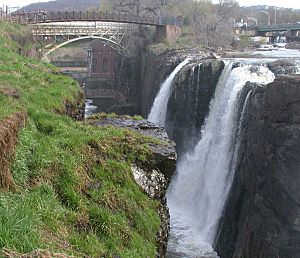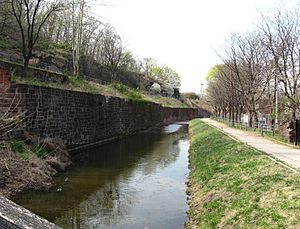Society for Establishing Useful Manufactures facts for kids
The Society for Establishing Useful Manufactures (S.U.M.) was a special company started in 1791. It was supported by the state of New Jersey. Its main goal was to help factories and industries grow along the Passaic River in New Jersey.
The S.U.M. company managed the powerful Great Falls of the Passaic River. They used the waterfall's energy to power factories. This led to the growth of Paterson as one of the first major industrial cities in the United States. For over 150 years, the area saw three big waves of industry. First, it was known for cotton factories. Then, it became famous for steel production. Finally, it was a center for making silk. Historians see S.U.M. as an early example of how governments and private companies can work together.

Contents
How the S.U.M. Began
Alexander Hamilton's Big Idea
The idea for S.U.M. came from Tench Coxe, who worked for the U.S. Treasury. He convinced United States Secretary of the Treasury Alexander Hamilton to support the plan. Hamilton had visited the Great Falls in 1778. He imagined it as a perfect place for a planned industrial city. He wanted to use the waterfall as a source of hydropower, which is power from moving water.
New Jersey officially approved the S.U.M. company under Hamilton's guidance. The company's job was to use the falls for this new city. Hamilton called it a "national manufactory," meaning a national factory center. The company did not have to pay property taxes for ten years. S.U.M. founded the city of Paterson near the falls. They named it after William Paterson, who was the governor of New Jersey.
Hamilton hired Pierre Charles L'Enfant, a famous engineer. L'Enfant had designed the layout for Washington, D.C. He was asked to design a system of canals called raceways. These raceways would carry water to power the watermills in the new town.
Changing How Things Worked
By 1796, S.U.M.'s own attempts to build factories had not worked well. The money they made was too slow to cover their starting costs. In 1791, they hired Thomas Marshall, who claimed to be a factory manager from England. But he was not successful.
However, S.U.M. found another way to succeed. They started selling or leasing land to other private companies. These companies could then build their own factories. S.U.M. kept control of the waterfall as the power source. They owned the dams and raceways that supplied water to the factories.
Managing the falls became a very profitable business for S.U.M. The area quickly became a hub for a growing factory industry. By 1815, there were thirteen water-powered cotton mills operating near the falls. More than 2,000 workers were employed there. Because S.U.M. was so successful in promoting industry, Paterson's population grew. It went from 500 people in the 1790s to over 5,000 by 1820.
In 1830, S.U.M. had a disagreement with the Morris Canal and Banking Company. This company wanted to build a canal connecting the Passaic River to the Delaware River. The Morris Canal Company built a dam on the Rockaway River. This dam took water for their canal, which reduced the water flowing over the Great Falls. This threatened S.U.M.'s businesses. A court decision allowed the Morris Canal to be built without stopping the water supply to the falls.
In 1834, a publisher named Thomas Gordon described how S.U.M. used the falls. He wrote that a dam directed water into a canal. This canal then supplied water to three levels of other canals. Each level gave the factories about 22 feet of water drop. This drop provided power. S.U.M. was responsible for maintaining the dams, canals, and gates. They also controlled the water flow.
Growth of Local Industries
New Types of Factories
During the 1800s, the success of the factories attracted many immigrants. People from England, Scotland, Ireland, and other parts of Europe came to Paterson. Many of them had experience working in factories. Some skilled workers even brought secret plans for British factory machines. These plans were then copied in Paterson.
By the 1830s, the textile mill industry in Paterson faced new challenges. Larger factories in New England that used steam power became more successful. As a result, Paterson's factories started making different things. They shifted to producing steel and locomotives (train engines). The Rogers Locomotive and Machine Works, which started in 1832, was a big success.
By the time of the American Civil War, making steel and locomotives was the main industry in Paterson. In the 1880s, the area became the center of the nation's silk industry.
S.U.M. continued to operate into the 1900s. However, as factories moved away from the area, the company declined. In 1945, the city of Paterson took over S.U.M.'s charter and property.
See also
- Technological and industrial history of the United States
- Holyoke Canal System, which also uses multi-level mill races
- Abraham Godwin


